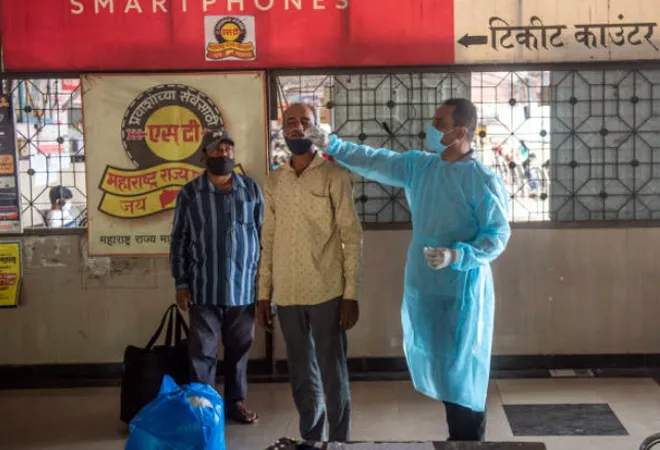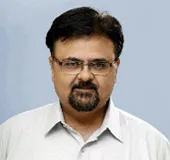
This article is part of the series Colaba Edit 2021.
Based on OECD’s definition of informal settlements, studies have estimated that up to 37 million households in India (nearly 50 percent of the country’s population) living in slums lack access to essential services including water and sanitation. These ‘informal settlements’ are concentrated within cities, where increasing densities have put unmanageable pressure on the provision of civic amenities and services.
As the COVID-19 pandemic struck India in early 2020, India’s dense megacities were expected to become the outbreak hotspots. India managed the first wave of the pandemic with some degree of success—thanks to the prolonged periods of lockdown, and by the end of 2020, the governments at both the centre and the states let their guard down. However, the second wave, which peaked in April and May 2021 with fierce intensity, exposed the deep faultlines in India’s urban capacity to deal with such an unprecedented catastrophe.
Though Maharashtra was by far the worst affected state in the country, Mumbai—despite 42 percent of its population in poor living conditions in slums and 57 percent of the families in one-room homes—relatively managed to quell the outbreak’s fury.
The disparity with which urban India combatted the pandemic’s second wave can be gauged from the experience of two of its largest urban agglomerations of Delhi and Mumbai. Though Maharashtra was by far the worst affected state in the country, Mumbai—despite 42 percent of its population in poor living conditions in slums and 57 percent of the families in one-room homes—relatively managed to quell the outbreak’s fury.
On the other hand, Delhi, having a comparable health infrastructure, saw an unprecedented shortage of essential medical supplies and hospital beds to cater to the exploding cases. When the pandemic peaked across India in April-May 2020, the national capital witnessed an average of 28,000 daily cases. The increased demand for hospital and ICU beds, oxygen and essential drugs laid bare the unpreparedness of the government machinery to deal with the unprecedented onslaught. Soon, city after city started reporting stories of death and despair.
In such a scenario, Mumbai, despite a few anxious moments, remained relatively calm even during the pandemic’s worst peak. Timely and deft interventions by the Municipal Corporation of Greater Mumbai (MCGM) led to a steady drop in the number of daily cases. The ‘Mumbai Model’ received international praise, while its counterparts across the country, including Delhi, were reprimanded for their failures by the Supreme Court.
The Mumbai Model
Steered under the overall supervision of the MCGM leadership and implemented across the city by the ward-level COVID War Rooms, the Mumbai model adopted a 360-degree approach to ensure the availability of ambulances, ICU beds, uninterrupted oxygen supplies and all critical medicines.
Oxygen: Oxygen supply to the Dedicated Covid Health Centres (DCHC) and Dedicated Covid Hospitals (DCH) treating the bulk of the moderately severe and severely ill patients who required medium to a high degree of oxygen support was prioritised in during the first peak itself. In May 2020, MCGM mapped its oxygen resources and prepared an inventory of the generation-to-bed supply chain of each hospital.
During the first wave, oxygen plants directly supplied liquid medical oxygen (LMO) in cryogenic tankers to all public and private hospitals, meeting 70 percent of the city’s total requirement. The rest came from refillers. However, as the second wave swelled, Mumbai fell short of localised oxygen storage capacity. MCGM addressed the problem by installing 22 cryogenic LMO storage tanks—13 hospitals with 13 kilolitre tanks each, seven with 10 kilolitres, and two with six kilolitre tanks each. From design and fabrication to operation, these tanks were built within 45 days.
Oxygen demand, which fell to the normal range of around 150 metric tonnes per day (MTPD) as the first wave receded, rapidly jumped to 270 MTPD in the second wave. MCGM swung into action to bridge the gap and procured an additional supply of 50 MTPD from steel plants in the neighbouring Raigad district and 60 MTPD from Jamnagar in Gujarat. Auxiliary oxygen storage depots were created at six strategic locations in Mumbai, with 25 jumbo tankers on standby; the War Rooms managed the coordination and logistics.
Learning from Brazil, where the third wave affected a large number of children, MCGM has also put in place measures for bulk procurement of paediatric medicines.
MCGM’s captive oxygen generation capacity of 500 cubic metres at the Kasturba Hospital and 1,740 cubic metres at the Trauma Hospital was sought to be augmented with higher-capacity plants at all its 25 hospitals and jumbo centres. These additional Pressure Swing Adsorption (PSA) plants, 16 of which have been installed, are expected to provide an additional 45 MTPD oxygen to Mumbai.
Medicines: As the shortage of Remdesivir gripped the country, MCGM acted swiftly and became the first municipal corporation to float a tender to procure 200,000 vials. Ignoring the criticism from opposition leaders, it adopted a ‘saving lives first’ approach and finalised the single bid received at a higher rate than prescribed by the state government.
In July 2020, when the shortage of Tocilizumab was reported from across the country, MCGM directly purchased 20,000 doses from Cipla, the drug’s sole distributor. Arrangements were also made with Biocon to procure Itolizumab, the drug that was given restricted emergency use authorisation by the Drug Controller General of India. MCGM also authorised the bulk purchase Amphotericin B, the drug used to treat mucormycosis or black fungus. Learning from Brazil, where the third wave affected a large number of children, MCGM has also put in place measures for bulk procurement of paediatric medicines.
Lessons from the Mumbai Model
While typical managerial concepts like planning, delegation and empowerment, pooling resources and leadership underpin the Mumbai Model, its biggest takeaway for urban India is its decentralised implementation. While the MCGM leadership remained in overall control, the fully-equipped 24 war rooms merged on an online dashboard and communications platform (even for crematoria across Mumbai). The War Rooms functioned with a great degree of autonomy, as the ward officer was empowered to think and act on their feet. The hub-and-spokes model ensured that those with lesser symptoms were triaged for home treatment and only the most critically ill patients were allotted an ICU bed.
The Mumbai Model has clearly shown how decentralised, collaborative and data-driven governance can effectively overcome such a crisis even in the densest and poorly-served urban habitats.
The views expressed above belong to the author(s). ORF research and analyses now available on Telegram! Click here to access our curated content — blogs, longforms and interviews.




 PREV
PREV


